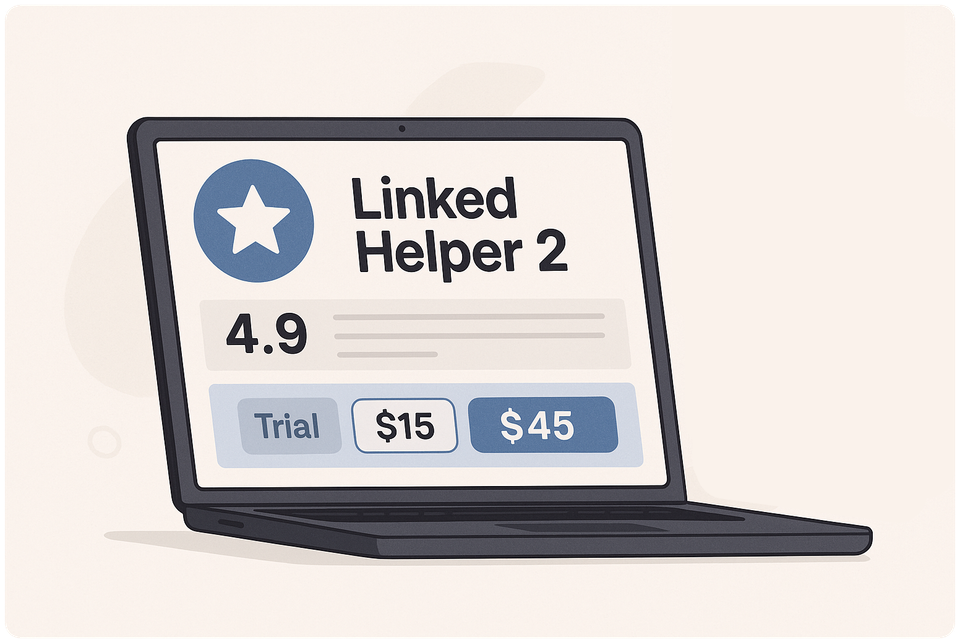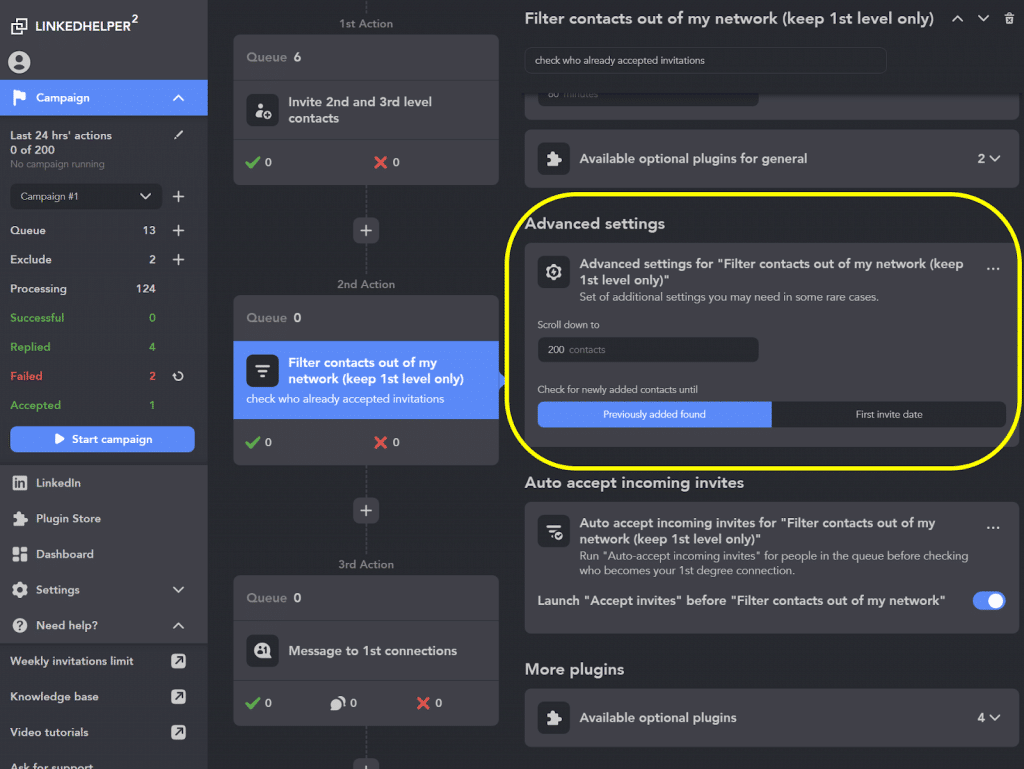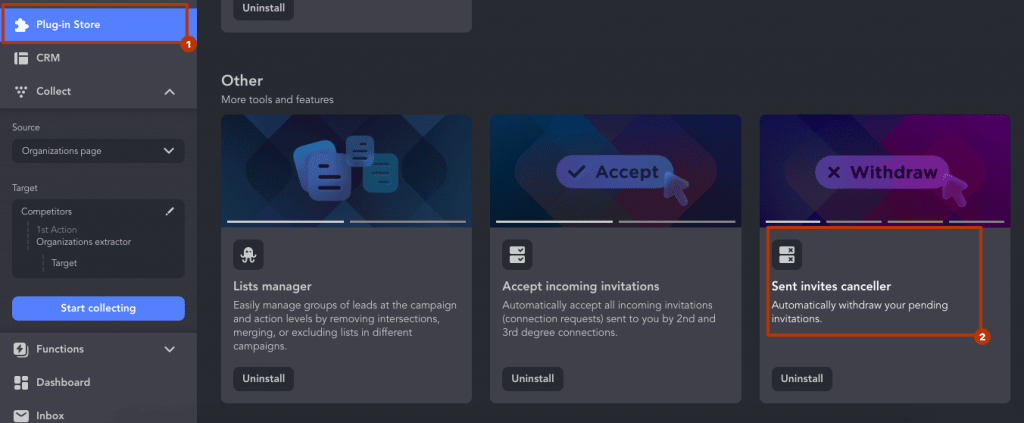Linked Helper Review 2025: Hidden Costs & Features After 2 Months of Testing

Linked Helper boasts a 4.9 rating on Capterra, where over 2.5 million verified reviews help users find authentic software experiences. After spending two months testing this desktop-based LinkedIn automation tool, I've identified both its strengths and limitations firsthand.
If you're looking to automate your LinkedIn outreach, Linked Helper 2 offers customizable campaign sequences and smart templates that run directly on your computer. The tool works with all Basic and Premium LinkedIn accounts, making it accessible for various user types. The pricing structure is simple: starting at $15 per month for the Standard plan and $45 monthly for the Pro plan, with a Free Trial option.
Is this highly-rated tool truly worth the investment? Does it deliver the promised automation capabilities without risking your LinkedIn account? Throughout this review, I'll share my unfiltered experience after daily use, including the hidden costs and limitations you won't find on their website.
What Is Linked Helper 2 and Who Is It For?

Linked Helper 2 stands out as a specialized desktop-based automation tool designed specifically for LinkedIn outreach. With over 300,000 satisfied users worldwide and a solid 7-year track record, this software has established itself as a reliable option for professionals seeking to enhance their LinkedIn networking capabilities. Unlike browser extensions, Linked Helper operates as a standalone application that can be downloaded to Windows, MacOS, or Ubuntu devices.
Core Use Cases for LinkedIn Outreach
At its core, Linked Helper 2 excels at automating personalized connection requests and message sequences. The platform allows users to create end-to-end workflows that handle everything from initial profile visits to follow-up messages after connections are accepted. Additionally, the tool offers integration with popular CRMs like HubSpot and Pipedrive.
Some of the primary use cases I've identified during my testing include:
- Lead prospecting and data extraction: The Visit and Extract feature lets you gather insights from profiles by scraping publicly available information.
- Engagement warming: The system can warm up leads before direct outreach by automatically liking posts, following profiles, and endorsing skills.
- Messaging automation: Users can create drip campaigns with personalized message sequences that include reply detection.
- LinkedIn group and event outreach: The tool enables bulk messaging to event attendees and group members.
Notably, Linked Helper also functions as a data collection tool. Through its scraping capabilities, you can analyze competitors' profiles, extract company information, and even capture messaging history to better understand your communication patterns.
Target Audience: Sales Teams, Freelancers, and Agencies
Based on my experience, Linked Helper caters to several distinct professional groups. Sales teams benefit from its ability to automate prospect identification and outreach while maintaining personalization. The platform's built-in CRM system allows sales professionals to organize contacts and track interactions efficiently.
Marketers constitute another key audience segment. The tool helps them automate lead generation tasks while collecting valuable business data for targeted campaigns. For freelancers and solopreneurs, Linked Helper offers an affordable way to maintain consistent outreach without dedicating hours to manual prospecting.
Lead generation agencies particularly value Linked Helper's multi-account management capabilities combined with its competitive pricing structure. This makes it an attractive option for agencies handling multiple client accounts simultaneously.
How It Works: Desktop-Based Automation
Unlike cloud-based alternatives, Linked Helper 2 operates directly from your desktop. Once installed, the application runs independently from your browser, making it one of the safer LinkedIn automation options available. Rather than injecting code into LinkedIn pages, it simulates human behavior such as clicks, typing, and scrolling.
The desktop-based nature of Linked Helper presents both advantages and challenges. On the positive side, this approach enhances security since it doesn't require direct API access to your LinkedIn account. Nevertheless, this setup also means your computer must remain on while campaigns are running—a limitation compared to fully cloud-based alternatives.
Setting up campaigns involves creating sequences of automated actions. These can include:
- Visiting profiles and extracting data
- Sending connection requests with personalized notes
- Following up with message sequences after connections are accepted
- Automatically tagging contacts based on their responses
The tool's CRM component stores all contact information when visiting LinkedIn profiles or communicating with prospects, allowing you to organize contacts with tags, notes, and interaction histories.
Top Features After 2 Months of Use

After two months of daily use, I've identified the most valuable features that separate Linked Helper 2 from the other connection tools. The platform offers 31 distinct automation capabilities that form a comprehensive LinkedIn outreach system.
Smart Campaign Templates and Message Sequences
The predefined campaign templates have consistently saved me hours of setup time. Linked Helper includes ready-to-use workflows for various scenarios, including warm-up sequences, follow-up chains, and group outreach campaigns. My most frequently used template is the "Warm-up, invite, and follow-up" option, which has increased my connection acceptance rates by 10–20%.
Message personalization stands out as exceptionally powerful. The Message Template Editor PRO supports conditional logic through IF-THEN-ELSE clauses. For instance, I created templates that send different message variations based on mutual connection counts, dramatically improving response rates. The platform also offers message randomization to avoid LinkedIn's pattern detection algorithms.
Built-in CRM and Tagging System
Linked Helper's integrated CRM has become my central hub for LinkedIn contact management. The system automatically stores all profile data when visited or communicated with, creating detailed contact cards with interaction histories. This feature has proven invaluable for tracking conversation progress across multiple campaigns.
What makes this CRM particularly effective is its filtering capability. I frequently filter contacts by relationship status (1st, 2nd, or 3rd-degree connections), company position, or custom tags. The tagging system allows for quick categorization of prospects, making follow-up campaigns significantly more organized.
Email Finder and Profile Scraping
The email finding functionality has consistently delivered value throughout my testing period. Linked Helper offers multiple methods to discover contact information beyond your immediate network. The built-in Email Finder provides credits with your subscription (610 credits for Standard and 3,200 for Pro accounts) to search for emails of 2nd and 3rd-degree connections.
In conjunction with the profile scraping tool, I've been able to extract comprehensive data from LinkedIn profiles. Beyond basic information, the system captures skills, messaging history, languages, and company data. All scraped information can be exported as CSV files or integrated with external CRMs through webhooks.
LinkedIn Group Invites and Auto-Follow
The group-based features have been especially useful for expanding my network within specific industries. Linked Helper enables messaging to group members even if they're outside my 1st-degree network - a functionality that effectively bypasses LinkedIn's usual connection requirements.
Moreover, the auto-follow capability serves as an excellent warming mechanism. Before sending connection requests, I typically follow target profiles, which creates visibility and familiarity. According to my testing, profiles who receive a connection request from someone already following them are substantially more likely to accept.
Conditional Actions and Drip Campaigns
The platform's workflow automation capabilities truly distinguish it from basic connection tools. Linked Helper supports multi-step sequences with smart delays between actions. I've created comprehensive funnels that begin with profile visits, progress to connection requests, and culminate in personalized message sequences.
The reply detection feature deserves special mention. The system monitors conversations for responses, automatically adjusting subsequent messages based on whether a reply was received. This creates natural conversation flows that feel genuine rather than automated. Additionally, the platform enables splitting longer messages into multiple parts with brief delays, mimicking natural typing patterns.
Hidden Costs and Limitations You Should Know

Despite its robust features, my experience with Linked Helper revealed several significant limitations worth considering before committing to this tool.
Desktop-Only Operation: Always-On Requirement
One major drawback is that Linked Helper functions exclusively as a desktop application that requires your computer to remain powered on for campaigns to run. Once I turned off my laptop, all prospecting activities immediately ceased. This creates a fundamental challenge when targeting prospects in different time zones or when traveling. Additionally, since all data is stored locally, switching computers requires manual transfer of databases through backups. Consequently, managing campaigns becomes particularly challenging for teams or users with multiple devices.
Proxy Setup and Technical Complexity
The proxy configuration process proved surprisingly complex, especially for managing multiple LinkedIn accounts. Although Linked Helper supports HTTP, HTTPS, SOCKS, and SOCKS5 proxies, setting them up demands technical knowledge that many marketers lack. The system requires ISP, residential, or mobile proxies rather than simple datacenter options. During testing, I discovered that proxy quality significantly impacts performance—LinkedIn assesses IP connections and may flag accounts with suspicious proxy settings.
No Unified Inbox for Message Management
Perhaps the most frustrating daily limitation was the absence of a unified messaging inbox. When using Linked Helper to check for replies from connections, all responses appeared as "read" in my LinkedIn inbox. Although the Messaging Hub attempts to address this by tracking replies, I found conversation management cumbersome—essentially no better than managing responses directly on LinkedIn. This fragmented approach made following up with prospects inefficient compared to cloud-based alternatives.
Risk of LinkedIn Account Restrictions
Although Linked Helper employs several safety measures, there remains an inherent risk of account restrictions. LinkedIn's detection algorithms monitor behavioral patterns and may flag suspicious activity. The platform limits accounts to approximately 100-150 actions daily, with new accounts restricted to merely 10-15 invites per day. While Linked Helper randomizes activities to mimic human behavior, the desktop-based nature potentially makes detection easier than cloud alternatives.
Email Finder Credit System Explained
The email finder feature operates on a credit system that constitutes a hidden cost. Each successfully found email address consumes one credit from your account. The Standard plan includes 620 credits monthly while the Pro plan offers 3,100. Notably, these credits reset with each subscription renewal—they don't accumulate. Additional credits can be purchased separately at rates ranging from $0.01 per lead, with package options from 1,000 credits ($15) to 50,000 credits ($284).
Linked Helper Pricing 2025: Is It Worth It?

Regarding pricing, Linked Helper operates on a license model instead of subscription-based billing. This means you purchase access for a set period without auto-renewal. Let's break down what you get at each pricing tier.
Free Trial: What's Included
The 14-day free trial provides access to all basic LinkedIn automation features. This includes the ability to send personalized messages, manage connection requests, and test essential functionality before committing financially. I found this sufficient time to evaluate whether the tool matched my workflow needs.
Standard Plan ($15/month): Key Features
The Standard plan starts at $15.00 monthly, with significant discounts for longer commitments—down to $8.25/month with annual billing (a 45% savings). The plan includes unlimited campaigns and the custom campaign builder, but restricts certain activities to 20 per day:
- Messaging LinkedIn group members and event attendees
- Likes and comments on posts
- Group and event invitations
- Messages with attached images
Importantly, this plan includes 620 email finder credits monthly, which reset with each billing cycle.
Pro Plan ($45/month): Advanced Capabilities
The Pro plan ($45/month or as low as $24.75/month with annual billing) removes daily limits on key actions. The substantial difference lies in unlimited messaging capabilities and 3,100 monthly email finder credits—five times more than the Standard plan. For high-volume outreach, this difference is substantial.
Cost vs Value: ROI for Different User Types
In terms of value, Linked Helper offers different returns depending on user profile. Based on my testing:
- Freelancers and solopreneurs gain excellent ROI from the Standard plan, as the core functionality remains intact despite limitations
- Small sales teams typically benefit more from the Pro plan due to unlimited messaging capabilities
- Agencies can leverage significant savings through Linked Helper's transparent bulk discounts
Compared to competitors, Linked Helper maintains the lowest entry price point—Lemlist's basic plan costs 6x more annually. This makes it particularly cost-effective for technical users who value granular control over their LinkedIn outreach.
Linked Helper vs Competitors: PhantomBuster, HeyReach & More
In comparing LinkedIn automation tools, understanding their fundamental operational differences becomes crucial for making an informed choice.
Linked Helper vs PhantomBuster: Engagement vs Scraping
While Linked Helper focuses on engagement-centric outreach through its building block action system, PhantomBuster operates with predefined "Phantoms" for scraping and automation. Price structures differ dramatically—PhantomBuster's Pro subscription costs approximately 5x more than Linked Helper Pro ($128 vs $24.50 monthly with annual plans). PhantomBuster imposes strict limits (15 slots and 80 hours monthly on Pro plan) whereas Linked Helper offers unlimited operation hours.
HeyReach vs Linked Helper: Multi-Account Outreach
HeyReach distinguishes itself as agency-focused software that enables managing 50+ LinkedIn accounts simultaneously. Its primary advantage is a unified inbox that consolidates conversations across multiple accounts—a feature Linked Helper notably lacks. This makes HeyReach potentially better for agencies, though at significantly higher cost points starting at $79/month.
Cloud-Based vs Desktop Tools: Which Is Safer?
The safety equation balances differently between these architectures. Cloud tools operate 24/7 without requiring your computer to remain on. Conversely, desktop applications like Linked Helper typically offer better security by storing data locally and more effectively mimicking human behavior through random delays and manual typing simulations.
When to Choose Linked Helper Over Others
Linked Helper stands out for technical users seeking granular control over automation at affordable prices. Its desktop-based structure provides enhanced security compared to browser extensions.
Our Verdict: Is Linked Helper Worth It?
After spending two months with Linked Helper 2, this tool clearly offers significant value for LinkedIn outreach despite several notable limitations. The combination of customizable campaign sequences, smart templates, and the built-in CRM system makes it a powerful option for professionals seeking to automate their LinkedIn prospecting efforts.
The pricing structure remains one of Linked Helper's strongest advantages. Standard plans starting at just $15 monthly (or $8.25 with annual billing) make it substantially more affordable than competitors like PhantomBuster, which costs approximately five times more. This accessibility certainly matters for freelancers and small businesses with limited marketing budgets.
Nevertheless, the desktop-only operation presents a genuine obstacle. Campaigns stop running when your computer shuts down, creating challenges for targeting prospects across time zones or during travel. Additionally, the lack of a unified inbox makes message management cumbersome compared to cloud-based alternatives.
Safety concerns deserve careful consideration before committing to any LinkedIn automation tool. Linked Helper attempts to mitigate risks through randomized activities and human-like behavior simulation, though LinkedIn's increasingly sophisticated detection algorithms still pose potential account restriction threats regardless of which tool you choose.
Technical users will undoubtedly appreciate the granular control Linked Helper provides. The conditional actions and drip campaigns enable sophisticated outreach sequences that feel personalized rather than automated. Still, less technical marketers might struggle with proxy setup requirements and overall system complexity.
Based on my extensive testing, Linked Helper delivers excellent value for specific user profiles. Freelancers, solopreneurs, and small sales teams with basic technical skills will benefit most from this tool, especially when price sensitivity is a factor. Agencies handling multiple client accounts, however, might find HeyReach's unified inbox and multi-account management capabilities worth the higher investment.
The final verdict depends largely on your specific needs and technical comfort level. Linked Helper excels as an affordable, feature-rich automation option for users willing to accept desktop-based limitations in exchange for powerful customization at an unbeatable price point.
FAQs: Linked Helper
What are the main features of Linked Helper 2?
Linked Helper 2 offers smart campaign templates, a built-in CRM system, email finder functionality, LinkedIn group invites, auto-follow capabilities, and conditional actions for drip campaigns. It allows users to automate personalized connection requests and message sequences on LinkedIn.
How much does Linked Helper cost?
Linked Helper offers a Standard plan starting at $15 per month (or as low as $8.25/month with annual billing) and a Pro plan at $45 per month (or $24.75/month annually). There's also a 14-day free trial available to test the basic features.
Is Linked Helper safe to use with my LinkedIn account?
While Linked Helper employs safety measures like randomized activities to mimic human behavior, there's always an inherent risk of account restrictions when using automation tools on LinkedIn. Users should exercise caution and adhere to LinkedIn's usage limits.
Can I use Linked Helper on multiple devices?
Linked Helper is a desktop-based application, which means it only runs on the computer where it's installed. Switching between devices requires manual transfer of databases through backups, which can be challenging for users with multiple devices or teams.
How does Linked Helper compare to cloud-based alternatives?
Unlike cloud-based tools, Linked Helper operates from your desktop, potentially offering better security by storing data locally. However, it requires your computer to remain on for campaigns to run, which can be a limitation compared to 24/7 cloud-based options. It's generally more affordable but may lack some conveniences like a unified inbox for message management.
